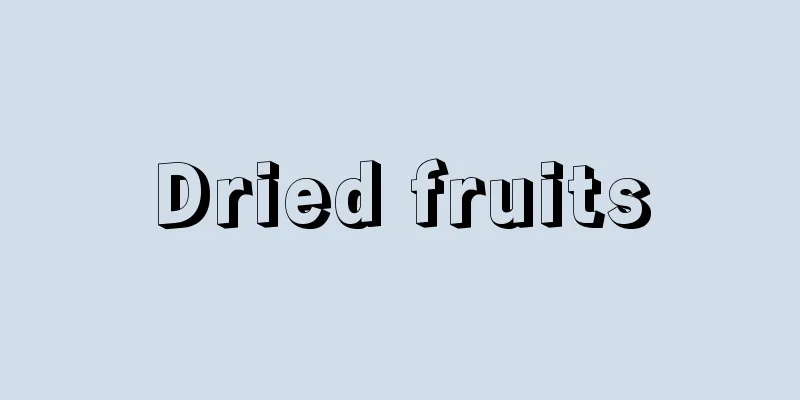Dried fruits

|
Dried fruits are processed foods that are dried by exposing them to sunlight, hot air, or freezing. They are also called dried fruits. Humans have eaten fruit since ancient times, and it is thought that people dried perishable fruits in the sun to preserve them. Dried figs have a long history, and were already a major industry over 1,000 years ago, with markets not only along the Mediterranean coast but also in Europe. In Japan, dried persimmons are the most common type of dried fruit, but there are not many other fruits, with only pears, peaches, loquats, apples, apricots, figs, etc. being dried. However, overseas, dried fruits are widely used, with many fruits being used, including grapes, bananas, cherries, lingonberries, nectarines, raspberries, plums, jujubes, papayas, and pineapples. [Tomomi Kono and Midori Otaki] Processing and UseTo prevent the fruit from browning during drying, they are treated with sulfur dioxide, a food additive with a bleaching effect, or, for those with a waxy skin, they may be treated with an alkaline solution before drying. Fruits used for processing into dried fruit are generally subject to changes during storage, so fruit that is slightly less than fully ripe is often used. However, for raisins and dried figs, it is better to leave them on the branch for as long as possible until they are slightly overripe, as this will increase their sugar content. Fruits are dried without heat treatment, either as is or with the skin peeled, so the enzymes contained in the fruit come into play to bring out the unique taste and aroma of dried fruit. Therefore, when added to sweets or processed foods, or used in cooking, you can enjoy a different flavor from raw fruit. Dried fruit contains less water, and the flavor is more concentrated accordingly. The sugar is particularly concentrated, making it sweeter, and the water-retaining properties of the sugar keep it moist, and the antioxidant properties of the sugar mean that the flavor does not change much even when stored for a long time. After drying, some are coated with vegetable oil or have sugar added to enhance their sweetness. [Tomomi Kono and Midori Otaki] The photo shows raw dried dried persimmons ©Shogakukan "> Dried persimmon ©Shogakukan "> Dried apricots ©Shogakukan "> Dried plums (prunes) Source: Shogakukan Encyclopedia Nipponica About Encyclopedia Nipponica Information | Legend |
|
果実を、日光、温風、あるいは凍結により乾燥した加工食品。ドライフルーツともいう。人間は古代から果実を食用としていたので、腐敗しやすい果実を保存のために日光で乾かしていたと考えられる。なかでも干しいちじくは古い歴史をもち、1000年余り前すでに大産業となっており、地中海沿岸はもちろん、ヨーロッパにも市場をもっていた。 日本では、乾燥果実の代表として干し柿(がき)があげられるが、ほかにはたいしたものはなく、わずかにナシ、モモ、ビワ、リンゴ、アンズ、イチジクなどが乾燥加工されているにすぎない。しかし、海外での乾燥果実の利用度は大きく、ブドウ、バナナ、サクランボ、コケモモ、ネクタリン、キイチゴ類、スモモ、ナツメ、パパイヤ、パイナップルなど多くの果実が用いられている。 [河野友美・大滝 緑] 加工・用途乾燥果実は乾燥中の褐変(かっぺん)防止のため、漂白作用のある食品添加物の二酸化硫黄(いおう)で処理したり、果皮に蝋質(ろうしつ)の多いものではアルカリ液処理をしたあと乾燥することもある。乾燥果実に加工する果実原料は、一般に貯蔵中の変化があるので、完熟よりすこし前のものが用いられることが多い。しかし、干しぶどうや干しいちじくでは、なるべく枝に長くつけておき、やや過熟になったもののほうが糖分含量が高くなるのでよい。果実は、熱処理などせず、そのまま、または皮をむいた状態で乾燥するので、果実の中に含まれている酵素が働き、乾燥果実独特の味や香りが出る。したがって、菓子や加工食品に加えるとか、料理に用いる際、なまの果実とは異なる風味を味わうことができる。乾燥果実は水分が少なく、味もそれだけ濃縮されたものになる。とくに糖分が濃縮されるので、甘味が強くなり、また、糖分の保水性により、しっとりした状態が保たれるうえ、糖分の酸化防止作用のため、長期間保存しても風味の変化が少ない利点がある。なお、乾燥後、植物油をからめたものや、加糖して甘味を強調したものなどもある。 [河野友美・大滝 緑] 写真は、生干しのあんぽ柿©Shogakukan"> 干し柿 ©Shogakukan"> 干しアンズ ©Shogakukan"> セイヨウスモモの乾果(干しプルーン) 出典 小学館 日本大百科全書(ニッポニカ)日本大百科全書(ニッポニカ)について 情報 | 凡例 |
Recommend
Bruegel - Bruegel (English spelling)
This family of painters from the Netherlandish re...
Mount Hiei
This mountainous area forms the border between Ky...
Mount Kano
This mountain is located in the southern part of ...
Assassin Bug - Osashigame
…He is said to be the founder of modern insect ph...
Eagle Stone
…The connection with keen eyesight is also seen i...
Cadastral map - Chisekizu
A map that shows the boundaries, parcel number, l...
Mr. Murakami
A group of pirates active in the Seto Inland Sea ...
Otton Frog - Otton Frog
A frog of the family Ranidae in the order Anura i...
Cover - Cover
This refers to the slight photographic density th...
Azekura-zukuri
This is an architectural style reminiscent of a st...
Kapila - Kapila (English spelling)
Date of birth and death unknown. Legend has it th...
Hichiriki - Hichiriki
A type of wind instrument found in China, Korea, a...
Petty average
…In the broad sense of average, there are losses ...
Puerta del Sol (English spelling)
…In 1202, Madrid was granted a city charter (ferr...
Karamizakura - Karamizakura
…Suminomizakura is used as an ingredient in proce...









